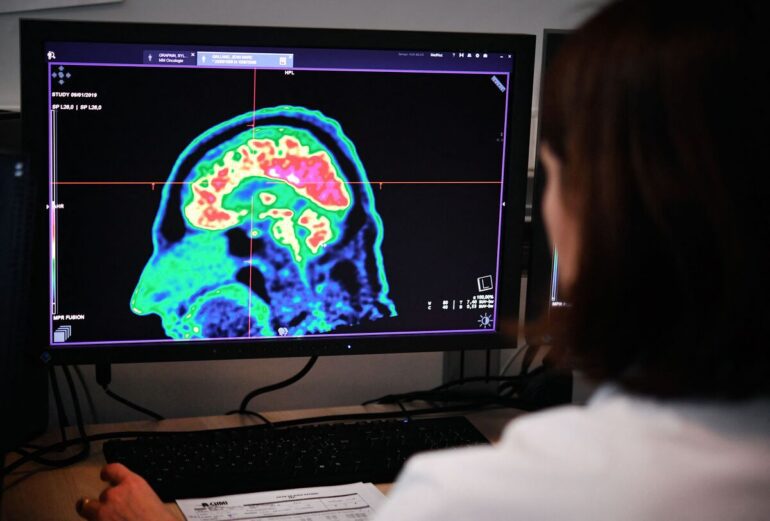TL;DR:
- An AI tool called Charm is aiding doctors in combating aggressive brain tumors by providing crucial guidance during surgery.
- Charm efficiently analyzes images to identify the genetic profile of gliomas, a type of aggressive brain tumor.
- It enables quick analysis, allowing doctors to proceed with appropriate treatment without additional surgeries, saving valuable time.
- Charm can distinguish between malignant and benign tumor cells and determine the tumor’s grade, reducing the need for a pathologist’s presence during surgery.
- Glioblastoma, a highly aggressive subtype of glioma, poses a significant threat with low survival rates.
- Charm outperforms other AI systems in identifying tumor genetic profiles, enhancing decision-making for surgeons.
- The research contributes to a broader range of AI initiatives to improve cancer diagnosis and treatment.
Main AI News:
Cutting-edge technology has taken a giant leap forward in the fight against aggressive brain tumors, thanks to the emergence of an artificial intelligence (AI) tool. This groundbreaking tool is revolutionizing the way doctors combat these challenging conditions by providing invaluable guidance during surgery, based on crucial characteristics identified through advanced image analysis.
Known as the Cryosection Histopathology Assessment and Review Machine (Charm), this state-of-the-art tool efficiently analyzes medical images to identify the genetic profile of gliomas, a particularly aggressive form of brain tumor. Traditionally, this process has been time-consuming, often taking days or even weeks. However, Charm expedites this critical analysis, enabling surgeons to make informed decisions and guide their operations with greater precision.
While Charm’s accuracy may not yet match that of current genetic tests, it can swiftly predict a tumor’s profile. This rapid analysis allows doctors to proceed with the most appropriate treatment without the need for additional surgeries, thus saving precious time. Kun-Hsing Yu, the senior author of a recent report in Med, emphasizes the importance of detailed diagnoses in guiding surgical procedures.
Furthermore, Charm has the remarkable ability to distinguish between malignant and benign tumor cells and determine the tumor’s grade, which indicates its level of aggressiveness. These assessments are typically made by human pathologists during surgery. However, Yu believes that Charm could eliminate the 10-to-15-minute wait or the requirement for a pathologist to be present during the operation.
Gliomas, particularly the aggressive subtype known as glioblastoma, pose a significant threat, with untreated cases often resulting in death within a mere six months. Tragically, the survival rate for individuals diagnosed with glioblastoma beyond the second year is a mere 17%, according to the American Association of Neurological Surgeons. To tackle this urgent challenge, Yu and his team trained a machine-learning algorithm using brain surgery samples and validated its accuracy against patient diagnoses. Remarkably, Charm outperformed other AI systems in identifying tumor genetic profiles.
Decisions regarding the extent of tissue removal and the potential use of drug-coated wafers in glioma tumor treatment rely heavily on the tumor’s genetic profile. However, obtaining this crucial information has been a time-consuming process. With Charm’s capabilities, surgeons can now access this information swiftly, enabling them to make critical decisions promptly and efficiently.
Yu’s research team’s groundbreaking work is part of a broader wave of initiatives that leverage AI to enhance cancer diagnosis and treatment. A notable editorial in the June edition of the Lancet Oncology emphasized the impressive capabilities of specific AI systems in accurately identifying individuals with an elevated risk of pancreatic, lung, and breast cancer. By harnessing the power of AI, medical professionals can make significant strides in the ongoing battle against cancer, offering hope and improved outcomes for patients worldwide.
Conclusion:
The emergence of Charm, an AI tool that assists surgeons in brain tumor treatment, represents a significant breakthrough in the market. By enabling quick and accurate identification of crucial tumor characteristics, Charm streamlines the decision-making process during surgery. This not only saves valuable time but also improves the precision and effectiveness of treatments. The success of Charm in distinguishing between different tumor types and grades positions it as a powerful ally for surgeons, enhancing their ability to combat aggressive brain tumors. As the field of AI continues to evolve, we can expect further advancements in medical technology, revolutionizing the market and improving patient outcomes.

